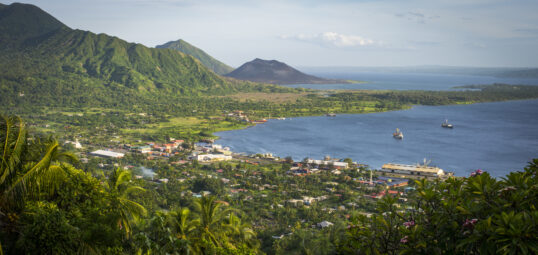Rabaul was heavily bombed during the war and devastated by volcanoes, but it pushes on and is a major destination for cruise ships and tourists. Marisa Howden reports on the town’s attractions and its ‘never say die’ spirit.

Rabaul’s Simpson Harbour, one of PNG’s busiest ports, with Mt Tavurvur in the background. Credit: Pacific Industries, PNGPTA and Agencies
Once deemed the ‘pearl of the Pacific’, Rabaul has a history as deep as the caldera it’s built on. Riddled with stories, the spirit of Rabaul continues to live on through its people and the historically significant sites such as the bunker of Japanese Admiral Isoroku Yamamoto (the mastermind behind the bombing of Pearl Harbor), and the memorials to Lark Force, a garrison of 1400 men who were left to defend Rabaul against an amphibious force of 20,000 Japanese soldiers.
Rabaul is also the site of PNG’s volcano observatory, which monitors not only Rabaul volcanoes but also others in the Pacific Islands region.
Why you must visit
Climbing volcanoes, visiting war relics, diving shipwrecks and reminiscing with locals … there’s plenty to do in Rabaul for the adventurous type.
You can easily fill a few days here if you’re willing to go off the beaten track. A climb of Tavurvur – a strenuous 45-minute walk up the active volcano just outside of town – will kickstart your day. Wear sturdy shoes as the surface is slippery, but you’ll be met with stunning views up top. See the megapod eggs and hot springs on your way down.
When you’re back at sea level, pay a visit to Rabaul’s oldest establishment, the New Guinea Club (key available from Rabaul Hotel). It was formed in 1919 and, remnants of the original building still stand, and the club now serves as a museum with relics and photos from World War 2.
After lunch, take a drive to the Rabaul Volcano Observatory and learn more about the volcanoes that the town is built around and the eruptions that have occurred over the years. The view from up here is special too. Finish your day with a cool drink at the Rabaul Yacht Club and meet a few old-timers who will regale you with stories of taim bipo (Tok Pisin for ‘previously’).
On your second day, head over Tunnel Hill Rd to the north coast and see a different side to Rabaul. Drive up to the submarine base the Japanese created to service their submarines from a network of tunnels.
The other way up the North Coast Road is a scenic drive looking out at Talili Bay, which was named after the first Tolai people who fought back against German colonisers.
Ratongor Catholic Mission is further along this road and is where more than 900 Chinese were interned during the war. Stop for lunch at Kulau Lodge and enjoy Rabaul’s beautiful black sand beaches.
All activities and cultural tours can be organised through a guide from Rabaul Hotel.
Be sure to …
See one of the cultural performances unique to East New Britain. Rabaul’s indigenous Tolai people are well known for their Kinavai ceremony. The Tolai men invoke the highly feared dukduks and tubuan spirits by dressing in cone-shaped masks with round balls of leaves across their bodies.
They arrive on canoes, as the Tolai first did when they migrated to Rabaul, and dance to kundu drums while the Tolai men perform a whipping ritual.
Journey further inland to the mountains where the Baining people live. Pushed out by the arrival of the Tolai, the Baining people are known for their fire dance, an initiation ceremony for young boys as they enter adulthood. Men hide their faces with large eerie-looking masks that have bulging eyes and protruding lips, and dance around the fire, kicking the embers to create fiery explosions.
Somewhere to stay
The Rabaul Hotel has stood the test of time and is one of the last remaining buildings in the old part of town. Its owner, Susie McGrade, grew up in Rabaul and is more than happy to help coordinate your trip. For something a little quieter, try Kulau Lodge on the North Coast Rd.
This article first published in the July–September issue of Paradise, the inflight magazine of Air Niugini.









Speak Your Mind